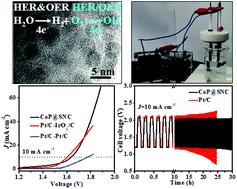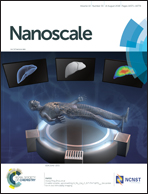Organophosphoric acid-derived CoP quantum dots@S,N-codoped graphite carbon as a trifunctional electrocatalyst for overall water splitting and Zn–air batteries†
Abstract
Developing highly efficient, low-cost, and multifunctional electro-catalysts to replace noble metals is of significant importance for energy storage and conversion systems. Herein, we demonstrate a facile strategy for the preparation of CoP quantum dots (QDs) embedded in S,N-codoped graphite carbon (CoP@SNC) by using organophosphoric acid as both phosphorus and carbon sources. Benefiting from the strong coupling and synergistic effect between CoP QDs and highly conductive S,N-codoped carbon, well-structured porosity and high specific surface area, the resulting CoP@SNC exhibits excellent activities for oxygen evolution reaction (OER), hydrogen evolution reaction (HER), and oxygen reduction reaction (ORR), making it a trifunctional electro-catalyst for overall water splitting and rechargeable Zn–air batteries. When CoP@SNC is used for overall water splitting, a cell voltage as low as 1.64 V is required to reach the current density of 10 mA cm−2; the obtained rechargeable Zn–air battery with CoP@SNC as the air cathode exhibits a high open-circuit voltage of 1.45 V, a very low discharge-charge voltage gap (0.83 V at 10 mA cm−2), and a long cycle life (up to 180 cycles). This work not only offers a new strategy for the synthesis of CoP@SNC but also presents its huge potential as a trifunctional electro-catalyst for clean energy systems.



 Please wait while we load your content...
Please wait while we load your content...